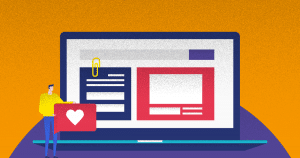Saying that eCommerce is truly competitive these days is an understatement, so you can’t afford to play guessing games when figuring out your customers.
You need a solid strategy for placing yourself firmly in your target customers’ shoes, getting into their heads, and anticipating their needs.
That’s where a really good eCommerce buyer persona can help.
Buyer personas can help you make sure you’re marketing your products and services to the right consumers.
They can also help you better tailor your marketing content to their exact needs, desires, and pain points, raising your chances of successfully converting them by quite a lot.
Here’s a closer look at everything you need to know to create a winning eCommerce buyer persona strategy that gets you results.
- Why Do You Need Buyer Personas?
- How Specific Should Your eCommerce Buyer Persona Be?
- How to Create Your First eCommerce Buyer Persona
- Tools to Help You Create Your Persona
- Wrap Up: Finetune Your Buyer Persona Strategy and Get Ahead this Year
Why Do You Need Buyer Personas?
When you know someone extremely well, it’s fairly easy to predict their behavior. You know their unique likes and dislikes.
You can anticipate how they might feel about something in particular with a fair amount of accuracy. And you likely know precisely what to say to them to persuade them to do something specific.
A well-crafted eCommerce buyer persona is a tool designed to help you get to know your hypothetical ideal customer on a similar level — a detailed semi-fictional digital portrait of who they are and what matters most to them.
Buyer personas, of course, contain all the details as to which demographics these hypothetical people belong to. It specifies their age, gender, profession, and location.
However, an eCommerce buyer persona also identifies any particular pain points or aspirations that make that person a perfect fit for your products.
A good eCommerce buyer persona naturalizes the process of getting into your target customer’s head.
In this way, it drives effective content creation, determines which marketing channels are the best fits, helps you wisely distribute your marketing budget, and more.
How Specific Should Your eCommerce Buyer Persona Be?
If your hypothetical ideal customer had a social media profile, it would look a lot like a skillfully-done eCommerce buyer persona.
It should contain a balanced mix of qualitative and quantitative details to be accurate and helpful.
Key Demographics
These are wide-reaching, objective factors that cover the basics of who your customers are as people. They include:
- Age
- Gender
- Geographic location
- Relationship status
- Family size
- Education level
- Profession, industry, and job title
- Income level
Habits and Interests
This portion of an eCommerce buyer persona takes you deeper into who the represented customer is. It covers personality traits, habits, interests, and other factors that might motivate them to make one purchase decision instead of another. They include:
- Short-term and long-term life goals
- Values and beliefs
- Hobbies and interests
- Key concerns and pain points
- Possible objections to your product
Online Presence and Spending Habits
Here’s where your eCommerce buyer persona gets into how your customer uses technology, spends their internet time, and ultimately decides how to spend their money.
You’ll use this portion of the persona to figure out where and how to reach your customer with the marketing content you’ll create.
Factors to consider adding include:
- Where the customer goes online for information
- What social media channels they use (and how often)
- How they prefer to communicate, especially with brands and businesses
- How and where they like to spend money online
- Where and how they like to shop, in general, including offline
Although some marketers feel that the more detailed a buyer persona is, the better, it’s important not to include details just for the sake of doing so.
Your personas should be well-rounded, highly specific portraits of your target customers. But they should only include information that’s necessary, helpful, and applicable to your marketing goals.
How to Create Your First eCommerce Buyer Persona
Ready to dive in and create your very first eCommerce buyer persona?
The following are a few basic steps to keep in mind. However, every marketing professional should finetune the details to fit their business goals and ongoing marketing strategies.
1. Decide what information you’ll collect
When building an accurate eCommerce buyer persona, you’ll conduct two different types of research — market research and customer research.
Market research involves collecting information about factors like pop culture, industry trends, the current economy, consumer trends, and similar.
Customer research involves data specific to your company’s existing and potential customers.
This is where you get into details regarding demographics, interests, motivations, pain points, personal goals, buying habits, etc.
2. Collect the necessary information
There are a few readily accessible ways to collect market research information for your eCommerce buyer persona, like Google Analytics and Facebook Audience Insights.
Use those options to collect basic information like key demographics and shared hobbies, interests, and values your desired customer might have.
It’s also a good idea to study industry consumer reports and social media material that might interest your target audience.
Customer research is always best when obtained directly on a one-to-one basis.
Put together surveys to collect the needed information, and offer incentives to motivate your customers to participate.
Person-to-person interviews are also great ways to get into a particular customer’s head. If your website or eCommerce shop utilizes a sign-up form, you should go over those for additional details, as well.
3. Decide on a way to organize your information
An excellent eCommerce buyer persona can get pretty detailed, so you’ll need to settle on a reliable way to keep all that information organized.
You can do this via a classic whiteboard, a spreadsheet, a handy template interface, or any combination of those.
Just make sure the method you choose is something all of your team members will have ongoing access to.
As you organize, look for common threads between identifying factors to understand your customer base better.
What similarities do customers with similar pain points share? Are they the same age or gender? Do they live in similar cities or types of neighborhoods?
Common themes emerge in exciting and practical ways when you’re working hard on a new eCommerce buyer persona, so keep your eyes peeled.
4. Consider your hypothetical customer’s buying journey
An eCommerce consumer’s decision to buy a particular product isn’t typically one decision at all.
Most go through an entire buyer’s journey with three stages.
First, the consumer becomes aware of the product, often through a piece of content that directly addresses a key concern they have. Then they consider that product and the various ways it might help them. Finally, they convert by finalizing a purchase.
Successful marketing means understanding this journey, especially regarding how it may differ from one eCommerce buyer persona to another.
It’s a vital part of creating content that successfully walks them through each stage of the buyer’s journey, up to and including conversion.
5. Consider potential triggers and tailor messaging to fit
Most customers don’t make their buying decisions in a vacuum.
There’s always an event, discovery, or other motivator that inspires them to take the next step — a trigger.
Your customer’s trigger is what sends them in your direction for a solution in the first place, so you’ll want to pinpoint what the potential triggers for your audience could be.
Triggers can take one of three different forms:
Internal Triggers
These can be ideas, feelings, or thoughts. They can also be positive (dreams and aspirations) or negative (worries and stressors).
External Triggers
These will be situations a customer can’t control but still needs to address. Think work assignments, events they need to plan, or something specific that’s missing from their life.
Seasonal Triggers
These can, of course, refer to established holidays and buying seasons. But they can also refer to common goals that frequently occur to people around specific times of year — like buying swimsuits for summer or getting in shape at the start of the year.
6. Start building your buyer persona
Here’s where you start bringing your new eCommerce buyer persona to life.
Be sure to include all the information you’ve collected on various aspects of your hypothetical customer’s personality in an organized manner.
Then take things a step further and flesh out your persona by asking yourself a few additional questions.
For instance, what stage of their customer journey are they in? Are they repeat customers, first-time buyers, or customers who have yet to purchase at all? What target messages and quotes can you add to your profile to make it more helpful?
Create as many personas as you need to accurately cover the different types of consumers who buy or could potentially be interested in your products.
Tools to Help You Create Your Persona
Need a hand when it comes to creating winning buyer personas? Try the following tools on for size.
Make My Persona
HubSpot specializes in informative marketing guides and helpful, user-friendly tools, so it’s no surprise that their go-to persona builder is a must-have.
Make My Persona is a simple tool that walks you through the process of eCommerce buyer persona creation one step at a time.
It’s especially helpful for those who already use other HubSpot products, as it integrates with them seamlessly.
The Ultimate Buyer Persona Generator
The Ultimate Buyer Persona Generator is a simple but thorough generator tool from the marketing wizards at Rock Content.
It guides you through the entire process of not only getting to know your customers better via persona creation but helping you settle on expertly tailored solutions that will raise conversion rates and inspire long-term customer loyalty.
Wrap Up: Finetune Your Buyer Persona Strategy and Get Ahead this Year
Knowing what to do to create a compelling eCommerce buyer persona is only part of putting together a strategy that really works.
It’s just as important to know what isn’t true of buyer personas today.
Check out our comprehensive guide on commonly believed buyer persona myths that are outdated, outmoded, or simply no longer true.
Then get to work finetuning your next set of personas to be even more accurate!










